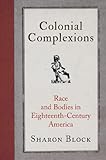Colonial Complexions : Race and Bodies in Eighteenth-Century America / Sharon Block.
Material type: TextSeries: Early American StudiesPublisher: Philadelphia : University of Pennsylvania Press, [2018]Copyright date: ©2018Description: 1 online resource (232 p.) : 17 illusContent type:
TextSeries: Early American StudiesPublisher: Philadelphia : University of Pennsylvania Press, [2018]Copyright date: ©2018Description: 1 online resource (232 p.) : 17 illusContent type: - 9780812294934
- Human body and language -- United States -- History -- 18th century
- Human skin color -- Social aspects -- United States -- History -- 18th century
- Race awareness -- United States -- History -- 18th century
- Racism -- United States -- History -- 18th century
- History-United States
- HISTORY / United States / Colonial Period (1600-1775)
- African Studies
- African-American Studies
- American History
- American Studies
- 305.800973
- E184.A1
- online - DeGruyter
| Item type | Current library | Call number | URL | Status | Notes | Barcode | |
|---|---|---|---|---|---|---|---|
 eBook
eBook
|
Biblioteca "Angelicum" Pont. Univ. S.Tommaso d'Aquino Nuvola online | online - DeGruyter (Browse shelf(Opens below)) | Online access | Not for loan (Accesso limitato) | Accesso per gli utenti autorizzati / Access for authorized users | (dgr)9780812294934 |
Browsing Biblioteca "Angelicum" Pont. Univ. S.Tommaso d'Aquino shelves, Shelving location: Nuvola online Close shelf browser (Hides shelf browser)

|

|

|

|

|

|

|
||
| online - DeGruyter Race and the Making of American Political Science / | online - DeGruyter Christian Slavery : Conversion and Race in the Protestant Atlantic World / | online - DeGruyter Argentina Betrayed : Memory, Mourning, and Accountability / | online - DeGruyter Colonial Complexions : Race and Bodies in Eighteenth-Century America / | online - DeGruyter God's Country : Christian Zionism in America / | online - DeGruyter City of Saints : Rebuilding Rome in the Early Middle Ages / | online - DeGruyter Resisting Occupation in Kashmir / |
Frontmatter -- CONTENTS -- Introduction -- Chapter 1. Complicating Humors and Rethinking Complexion -- Chapter 2. Shaping Bodies in Print: Labor and Health -- Chapter 3. Coloring Bodies: Naturalized Incompatibilities -- Chapter 4. Categorizing Bodies: Race, Place, and the Pursuit of Freedom -- Chapter 5. Written by and on the Body: Racialization of Affects and Effects -- Epilogue -- Appendix 1. Advertisements for Runaways: Sources and Methodology -- Appendix 2. Graphic Overview of Advertisements for Runaways -- Appendix 3. Newspapers with Advertisements for Runaways (1750–75) -- Notes -- Index -- Acknowledgments
restricted access online access with authorization star
http://purl.org/coar/access_right/c_16ec
In Colonial Complexions, historian Sharon Block examines how Anglo-Americans built racial ideologies out of descriptions of physical appearance. By analyzing more than 4,000 advertisements for fugitive servants and slaves in colonial newspapers alongside scores of transatlantic sources, she reveals how colonists transformed observable characteristics into racist reality. Building on her expertise in digital humanities, Block repurposes these well-known historical sources to newly highlight how daily language called race and identity into being before the rise of scientific racism.In the eighteenth century, a multitude of characteristics beyond skin color factored into racial assumptions, and complexion did not have a stable or singular meaning. Colonists justified a race-based slave labor system not by opposing black and white but by accumulating differences in the bodies they described: racism was made real by marking variation from a norm on some bodies, and variation as the norm on others. Such subtle systemizations of racism naturalized enslavement into bodily description, erased Native American heritage, and privileged life history as a crucial marker of free status only for people of European-based identities.Colonial Complexions suggests alternative possibilities to modern formulations of racial identities and offers a precise historical analysis of the beliefs behind evolving notions of race-based differences in North American history.
Mode of access: Internet via World Wide Web.
In English.
Description based on online resource; title from PDF title page (publisher's Web site, viewed 04. Okt 2022)


